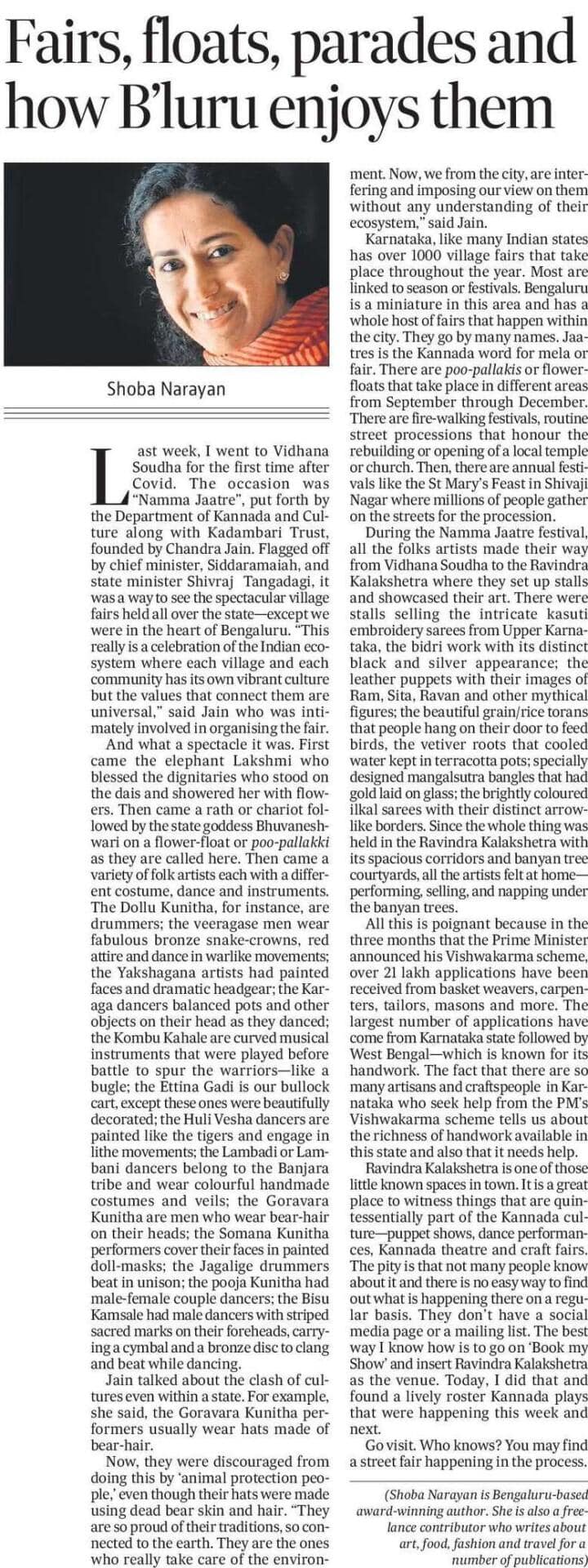Last week, I went to Vidhana Soudha for the first time after Covid. The occasion was “Namma Jaatre,” put forth by the Department of Kannada and Culture along with Kadambari Trust, founded by Chandra Jain. Flagged off by Chief Minister, Siddaramaiah, and Minister Shivraj Thangadagi, it was a way to see the spectacular village fairs held all over the state—except we were in the heart of Bangalore. “This really is a celebration of the Indian ecosystem where each village and each community has its own vibrant culture but the values that connect them are universal,” said Jain who was intimately involved in organising the fair.
And what a spectacle it was. First came the elephant Lakshmi who blessed the dignitaries who stood on the dais and showered her with flowers. Then came a rath or chariot followed by the state goddess Bhuvaneshwari on a flower-float or poo-pallakki as they are called here. Then came a variety of folk artists each with a different costume, dance and instruments. The dollu kunitha, for instance, are drummers; the veeragase are men with fabulous snake crowns, red attire and warlike movements; the yakshagana artists had painted faces and wide headgear; the karaga dancers balanced pots and other headgear as they moved; the kombu kahale are curved musical instruments that were played before battle to spur the warriors—like a bugle; the ettina gadi is our bullock cart, except these ones were beautifully decorated; the huli vesha are dancers who are painted like the tigers and engage in lithe movements; the lambadi or lambani dancers belonged to the Banjara tribe and wear colourful handmade costumes and veils; the goravara kunitha are men who wear bear-hair on their heads; the somanna kunitha had performers who covered their faces in painted doll-masks; the jagalige drummers beat in unison; the pooja kunitha had male-female couple dancers; the bisu kamsale had male dancers with striped sacred marks on their foreheads, carrying a cymbal and a bronze disc to clang and beat while dancing.
Jain talked about the clash of cultures even within a state. For example, she said, the goravara kunitha performers usually wear hats made of bear-hair. Now, they said, they were discouraged from doing this by ‘animal protection people,’ even though their hats were made using dead bear skin and hair. “They are so proud of their traditions, so connected to the earth. They are the ones who really take care of the environment. Now, we from the city, are interfering and imposing our view on them without any understanding of their ecosystem,” said Chandra Jain.
Karnataka, like many Indian states has over 1000 village fairs that take place throughout the year. Most are linked to season or festivals. Bangalore is a miniature in this area and has a whole host of fairs that happen within the city. They go by many names. Jaatres is the kannada word for mela or fair. There are poo-pallakis or flower-floats that take place in different areas from September through December. There are fire-walking festivals, routine street processions that honour the rebuilding or opening of a local temple or church. Then, there are annual festivals like the St. Mary’s Feast in Shivaji Nagar where millions of people gather on the streets for the procession.
During the Namma Jaatre festival, all the folks artists made their way from Vidhana Soudha to the Ravindra Kalakshetra where they set up stalls and showcased their art. There were stalls selling the intricate kasuti embroidery sarees from Upper Karnataka, the bidri work with its distinct black and silver appearance; the leather puppets with their images of Rama, Sita, Ravana and other mythical figures; the beautiful grain/rice thorans that people hung on their door to feed birds, the vetiver roots that cooled water kept in terracotta pots; specially designed mangalsutra bangles that had gold laid on glass; the brightly coloured ilkal sarees with their distinct arrow-like borders. Since the whole thing was held in the Ravindra Kalakshetra with its spacious corridors and banyan tree courtyards, all the artists felt at home—performing, selling, and napping under the banyan trees.
Ravindra Kalakshetra is one of those little known spaces in town. It is a great place to witness things are quintessentially part of the Kannada culture—puppet shows, dance performances, Kannada theatre and craft fairs. The pity is that not many people know about it and there is no easy way to find out what is happening there on a regular basis. They don’t have a social media page or a mailing list. The best way I know how is to go on ‘Book my Show’ and insert Ravindra Kalakshetra as the venue. Today, I did that and found a lively roster kannada plays that were happening this week and next.
Go visit. Who knows? You may find a street fair happening in the process.
Shoba Narayan is Bangalore-based award-winning author. She is also a freelance contributor who writes about art, food, fashion and travel for a number of publications.



-k4lD-U204025897261YmH-250x250%40HT-Web.jpg)




Leave A Comment